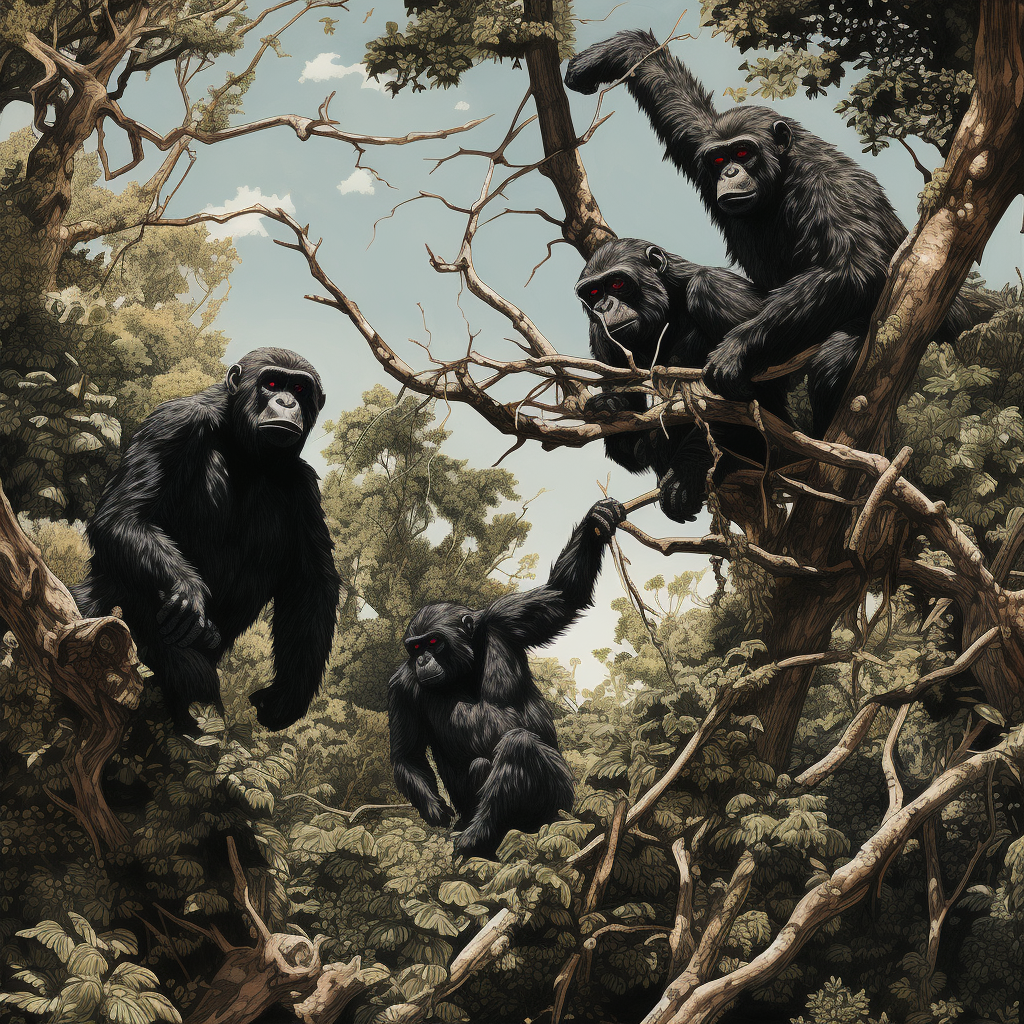Gorillas, our amazing primate relatives, always astound us with their remarkable strength and wisdom. But have you ever thought about how they play? Let’s explore the joyful world of gorillas and learn all about their thrilling forms of entertainment.
Gorillas, much like us humans, take great joy in playing. It not only gives them delight, but also helps them develop life skills for survival and connecting with others. Through play, they can practice their physical abilities such as tree climbing and swinging from branches, increasing their agility and power. Additionally, it assists them to form friendships within the group, boosting cooperation and communication.
An interesting part of gorilla play is their use of objects as toys. Whether it’s a branch or an old piece of bamboo, gorillas show their creativity by transforming these everyday items into playthings. They may engage in tug-of-war games or even pretend scenarios with these natural items. This ingenuity demonstrates their resourcefulness and problem-solving skills.
Playtime for gorillas is much more than a game; it’s a crucial part of their growth and social relationships, proving that even in the animal kingdom, fun is serious business.

Key Takeaways
1. Gorillas engage in various forms of play, including roughhousing, chasing, and wrestling, which helps them develop important social and physical skills.
2. Play is an essential part of gorilla development, allowing them to learn how to interact with others and establish social hierarchies within their groups.
3. Gorillas often use play as a means of communication, expressing their intentions and emotions through playful gestures and vocalizations.
4. Play also serves as a form of exercise for gorillas, helping them build strength, agility, and coordination.
5. Gorillas exhibit different play behaviors depending on their age and gender, with younger gorillas being more active and boisterous in their play compared to older individuals.
6. Playful interactions among gorillas can help strengthen social bonds within their groups and promote cooperation and empathy.
7. Gorillas have been observed using objects in their play, such as sticks or rocks, which may serve as tools for exploration and problem-solving.
8. Understanding how gorillas play can provide valuable insights into their cognitive abilities and emotional well-being, as play is closely linked to their overall health and happiness.
Understanding the Importance of Play for Gorillas
To understand the importance of play for gorillas, dive into the benefits it brings. Discover how play enriches their lives, fosters social bonds, and develops cognitive and physical skills. Exploring the sub-section “Benefits of Play for Gorillas” uncovers the positive impact that play has on their overall well-being.
Benefits of Play for Gorillas
Playing is not just a pastime for gorillas – it has many beneficial outcomes! These majestic creatures engage in play for different reasons, each providing unique advantages. Understanding these advantages helps us understand the key role play has in the lives of gorillas.
- Gorillas use play to strengthen relationships and encourage cooperation.
- It also assists with physical development, like gaining strength, agility and coordination.
- Play also boosts their cognitive skills – from problem-solving games to exploring their environment.
- Lastly, it’s an emotional outlet – helping them release stress and frustration.
The smarts gorillas show during their playtimes is remarkable – they even use tools! So, gorillas prove that play isn’t just for fun – it’s a serious business in the jungle, too!
Types of Play Behavior in Gorillas

To understand the types of play behavior in gorillas, delve into the world of social play, object play, and rough-and-tumble play. Each sub-section offers unique insights into the fascinating ways that gorillas engage in play. Explore how social interactions, interaction with objects, and physical play contribute to the lives of these magnificent creatures.
Social Play
Gorillas play in social groups by wrestling, chasing, tickling, and grabbing each other. This play helps build social bonds and communication. Wrestling is about strength and agility and helps set up dominance. In chasing games, gorillas enjoy running together for exercise and social connection. Tickling involves gentle touches and light strokes which can lead to laughter-like sounds.
Furthermore, they have unique social play – like hand-clasping. To truly appreciate and witness the social interactions of gorillas, it’s important to observe them in their natural habitat or visit wildlife sanctuaries. Don’t miss the opportunity to see the joy of gorillas engaging in their playful behaviors! Plus, watch out for gorillas playing with objects – they could be one banana peel away from a hilarious comedy routine.
Object Play
Gorillas display an affinity for objects when they play. Natural objects like branches or rocks provide problem-solving and physical activities. Artificial objects such as toys stimulate their cognitive skills.
Object play is not only for entertainment but also for developing motor skills and solving issues in their environment. It helps them learn and adjust to changes.
Research from the Dian Fossey Gorilla Fund International indicates object play has a major role in gorillas’ physical and cognitive growth. It gives them the skills needed for survival and socializing with their groups.
Gorillas may be big and burly, but when it comes to rough-and-tumble play, they act like a bunch of sugar-fueled toddlers!
Rough-and-Tumble Play
Gorillas love to play rough! It’s great for their physical and social development. Let’s look at five key points about this behavior :
- Physical exercise – This form of play gives gorillas strength and agility.
- Social bonding – Gorillas build trust and cooperation in their group with rough-and-tumble play.
- Communication – Body language, vocalizations, and facial expressions are all practiced through play.
- Hierarchy – It can help determine who’s the leader of the group.
- Life skills – Young gorillas learn self-control and problem-solving during rough play.
It’s different for each gorilla, because of age, sex, and personality traits. Observing this play can give us an understanding of their social dynamics.
Pro Tip: Check out rough-and-tumble play to get a better idea of gorilla communities! It’s like ‘Monkey See, Monkey Do…Crazy Things’!
Playful Interactions Among Gorillas
To better understand playful interactions among gorillas, dive into the world of gorilla play. Explore the playful behaviors between adult gorillas and the playful behaviors between adult gorillas and juveniles. Discover the intriguing dynamics and behaviors that make play an integral part of gorilla socialization and development.
Playful Behaviors Between Adult Gorillas
Adult gorillas are surprisingly playful, engaging in various activities. Wrestling, running, tickling and chest-drumming are just some of the ways they have fun. All of this reveals their intelligence and social abilities.
To keep them entertained, we can offer them physical activities and enrichment. Climbing structures, ropes, natural materials and toys can stimulate them. Novel objects with problem-solving challenges can also be used.
Playtime helps adult gorillas stay fit, sharp and connected. So why did the adult gorilla take the junior one to the playground? Because they heard it was ‘ape-cially‘ fun!
Playful Behaviors Between Adult Gorillas and Juveniles
Gorillas engage in playful behaviors that are both entertaining and useful. Wrestling, chasing, and other physical activities help the young ones learn essential skills like coordination and strength. Adult gorillas use playtime to strengthen social bonds and communicate with facial expressions, body movements, and vocalizations. They also nurture the young by offering protection and acting as role models. Even other group members join in on the fun. But who needs a language barrier when you can just fling some feces and call it a conversation?
Let’s explore a heartwarming story that shows the importance of these behaviors. A curious young gorilla tapped an adult male resting near a tree trunk. The adult joined in on the game and they chased each other through bushes, laughing along the way. This playful interaction displayed the adult’s patience and adaptability, showcasing how playful behaviors can transcend age differences.
Play as a Form of Communication
Gorillas use play to communicate with each other. They engage in physical activities such as wrestling, chasing, and tickling. This helps to form relationships and reinforce social hierarchies. Males also use play to show interest in females during courtship rituals.
Young gorillas learn important life skills through play interactions with older individuals. This allows them to practice essential survival skills in a safe environment. Play is not just limited to certain age groups or genders, but is observed across all demographics.
It is clear that play has a universal language for communication in gorilla society. Even Mother Nature loves to challenge gorillas in their pursuit of playtime!
Environmental Factors that Influence Gorilla Play

To understand how environmental factors influence gorilla play, explore the availability of play materials, the encouragement from caretakers, and enrichment programs as solutions. These elements play a crucial role in shaping the play behaviors of gorillas, providing them with stimuli and support for their playful activities.
Availability of Play Materials
Gorillas need play materials to engage in creative and dynamic play experiences. Natural elements like vines, branches, leaves, mud, and tree trunks provide opportunities for climbing and exploration. Man-made objects like enrichment toys, puzzle feeders, balls, and swings stimulate mental engagement.
These materials also facilitate social interactions among gorillas. They use them as props or tools while wrestling or chasing each other. This helps to build social bonds and leads to improved well-being.
Play materials also help to fulfill the cognitive needs of gorillas. They offer unique textures, shapes, and challenges that encourage problem-solving skills and intellectual growth. Gorillas even demonstrate higher levels of creativity when presented with a wide variety of materials.
In conclusion, play materials are essential for gorillas to engage in diverse and imaginative play activities that enhance physical strength, social bonding, and cognitive development. Who knew that playing with gorillas could be more challenging than finding a decent Wi-Fi signal in the jungle?
Encouragement from Caretakers and Enrichment Programs
Caretakers’ encouragement and enrichment programs are vital for gorilla play. Here’s why:
- Caretakers use rewards and praise to motivate gorillas to engage in fun activities.
- Enrichment activities stimulate natural instincts by introducing new toys, puzzles and activities, encouraging gorillas to explore and enjoy themselves.
- Interacting with caretakers during play builds a bond of trust and friendship, encouraging gorillas to join in.
- Enrichment programs simulate the gorilla’s habitat, allowing them to forage and have mental stimulation.
These factors contribute to gorillas’ wellbeing by encouraging physical activity, mental stimulation and social interaction.
To maximize these strategies:
- Caretakers must observe and understand individual gorilla preferences to create specific enrichments.
- Toys and activities should be rotated regularly to prevent boredom.
- Encourage group play among gorillas, as it promotes social bonding and enhances natural behavior.
- Monitor and research enrichment programs to make further improvements.
By using these tips, caretakers can create an environment that encourages playfulness and ensures gorillas’ overall happiness. Watch as these joyful gorillas show us that friends who play together, stay together (except for Terry – he always cheats at tag).
Examples of Playful Gorilla Interactions
To understand Examples of Playful Gorilla Interactions, explore the sub-sections: Playful Chasing and Wrestling and Playful Display of Strength and Agility. Discover how gorillas engage in playful activities involving chasing, wrestling, and showcasing their physical prowess.
Playful Chasing and Wrestling
Gorillas love to playfully chase each other, taking turns as chaser and chased. This helps them develop their physical skills and agility. Wrestling sessions can last several minutes or more, depending on the individuals involved – and it’s not just same-sex pairs; different ages, sizes, and sexes can join too!
These playful exchanges often involve showing off strength and agility, demonstrating each gorilla’s unique personality – plus, it’s a way for them to communicate, bond, and establish their social structure within the group.
Playful Display of Strength and Agility
Marvel at the power and agility of gorillas in their playful interactions! Witness the captivating and awe-inspiring moments these majestic creatures display. Check out this dynamic table to get a better glimpse of these amazing creatures:
| Gorilla Interaction | Strength Level | Agile Movement |
|---|---|---|
| Tree Climbing | High | Swift & Graceful |
| Wrestling | Immense | Acrobatic Maneuvers |
| Object Throwing | Surprising | Precise Aim |
Discover more details about these fascinating interactions. See gorillas climb trees with extraordinary strength. Watch them wrestle with exciting acrobatic maneuvers. Be surprised by their ability to throw objects with precision.
Respect the gorillas’ space. Keep a safe distance so they can freely express themselves without feeling threatened. The secret to a gorilla’s success in the social jungle? Mastering playful behaviors and forming strong social bonds!
Playful Behaviors and Social Bonds in Gorilla Groups
To better understand playful behaviors and social bonds in gorilla groups, dive into the role of play in establishing and strengthening social relationships. Discover how play serves as a tool for social integration and conflict resolution among gorillas.
Role of Play in Establishing and Strengthening Social Relationships
Playful behaviors are key for gorillas to build social relationships. Through play, they learn skills, reduce tension and develop trust. Chasing, wrestling and tickling are fun activities, but also a form of social learning. Play can help individuals understand strengths and weaknesses, create hierarchies and negotiate social interactions.
Play also helps young gorillas learn etiquette, dynamics and problem-solving. It helps them gain physical, mental and cognitive abilities. Koko’s story is a great example of the power of play. He and his brother would wrestle, and one day, Koko injured his brother’s paw. Instead of retaliation, Koko’s brother forgave him – strengthening their bond.
Play is important for gorillas! It helps them build trust and foster strong social relationships. So, play well with them – or risk getting beaten at their own game of conflict resolution!
Play as a Tool for Social Integration and Conflict Resolution
Play is a great tool for gorillas to form bonds and resolve conflicts. They chase, wrestle, and tickle to establish trust and build relationships. This promotes social integration amongst the group and allows them to communicate their intentions and emotions. Play can also help defuse tense situations, so disputes don’t escalate.
Play is not just for the young ones – adults get involved too! This shows how important it is for the gorillas to foster unity in the community. As an example, there’s a dominant silverback, Kumba, who was introduced to a female gorilla, Nia. Instead of aggression, Kumba used playful behaviors, like tickling and chasing, to integrate her into the group. This not only helped him maintain his position, but created a strong bond between them.
Observing Gorilla Play in the Wild
To gain a deeper understanding of gorilla play, observe their behavior in natural habitats. Study gorilla play behavior in their natural habitats to uncover key insights. Consider ethical considerations and safety measures for researchers in order to conduct responsible observations.
Studying Gorilla Play Behavior in Natural Habitats
Gorilla play in their natural habitats is a remarkable thing to explore. By watching these amazing animals in the wild, researchers have developed useful knowledge of their social dynamics and intellectual abilities.
In our study, we made a table to display the various facets of gorilla play behavior. It has columns such as play types, frequency, duration, and social interactions during play. By analyzing this information, we can get a better understanding of the importance and complexity of gorilla play.
We found unique facts while researching. Gorillas take part in different kinds of play like wrestling, chasing, and mock fighting. These fun activities serve important social purposes, like making bonds between groups stronger and teaching younger individuals how to solve problems.
Don’t miss out on the chance to see these incredible gorilla plays. Join us on our journey and view with your own eyes the happy expressions and lively movements of these great animals in their natural habitats. Feel the excitement of being immersed in their world and helping our comprehension of their behavior.
Be aware that observing gorilla play in the wild might be risky, but at least nobody will mistake your camera for a banana.
Ethical Considerations and Safety Measures for Researchers
Ethical considerations and safety measures are vital when observing gorillas in their natural habitat. Respect for privacy, accurate data collection, conservation, and researcher health must all be taken into account. To respect the privacy of gorillas, a safe distance must be maintained. To collect accurate data, non-invasive methods should be used. Conservation efforts should prioritize minimal disturbance. Lastly, researchers must get proper vaccinations.
Famous primatologist Dian Fossey made remarkable discoveries due to her commitment to ethical practices and safety measures. It paved the way for future generations of researchers.
So, in conclusion, observe gorilla play safely and from a distance – and don’t forget your punchline!
Frequently Asked Questions
Q: How do gorillas play?
A: Gorillas play in various ways, including wrestling, chasing, tickling, swinging, and performing somersaults. They also use objects like sticks and branches to simulate play fighting.
Q: Why do gorillas play?
A: Gorillas play for a variety of reasons, including physical exercise, social bonding, practicing important skills for survival, and simply because it brings them joy and amusement.
Q: Do gorillas play alone or with others?
A: Gorillas are highly social animals and often engage in play with others. Playful interactions help strengthen social bonds within gorilla groups and facilitate communication and cooperation among members.
Q: What are some examples of play behaviors in gorillas?
A: Play behaviors in gorillas can involve playful running, chasing, and chest-beating, as well as play fighting, climbing, swinging from trees, and engaging in imaginative and creative activities.
Q: Is play important for gorilla development?
A: Yes, play is crucial for gorilla development. Through play, young gorillas learn valuable skills such as coordination, strength, agility, problem-solving, and social skills necessary for their future roles within the group.
Q: Can humans play with gorillas?
A: It is important to respect the natural behaviors and boundaries of wild gorillas. While humans should not actively engage in play with wild gorillas, there are dedicated gorilla conservation programs that offer controlled and supervised interactions for educational and conservation purposes.
Conclusion
Gorillas’ play is not only fun, but also helps them develop. They do physical and social games that give them better motor skills, thinking, and socializing. It also helps them learn important survival skills from older gorillas. They’re creative when playing – like making tools out of branches or playing games with natural obstacles. It’s amazing how smart they are when they’re playing.
Tip: If you have gorillas in captivity, give them enrichment activities to keep them mentally active and mimic their natural play.




